This article was published in Scientific American’s former blog network and reflects the views of the author, not necessarily those of Scientific American
An abundance of morphological and molecular data shows beyond reasonable doubt that salamanders (properly Urodela or Caudata*) are close kin of anurans and are hence deeply nested within Tetrapoda. And caecilians – while somewhat controversial (we’ll get to that later) – are definitely tetrapods of some sort too. But mostly forgotten today is the once familiar 20th century idea that salamanders and caecilians are ‘tetrapod mimics’ that evolved independently from an entirely separate group of lobe-finned fishes, either the porolepiforms, a group today thought to be stem-members of the lungfish lineage, or from lungfishes themselves.
* Urodela and Caudata have often been used as if they’re synonymous. But in the phylogenetic literature, Urodela pertains to the crown-group only, Caudata to the whole branch.
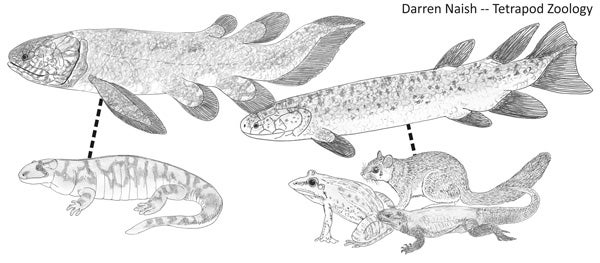
Do salamanders descend from the lungfish-like porolepiforms - as shown at left - while all other tetrapods descend from osteolepiforms, as shown at right? Illustrations from The Big Book project (on which go here). Credit: Darren Naish
On supporting science journalism
If you're enjoying this article, consider supporting our award-winning journalism by subscribing. By purchasing a subscription you are helping to ensure the future of impactful stories about the discoveries and ideas shaping our world today.
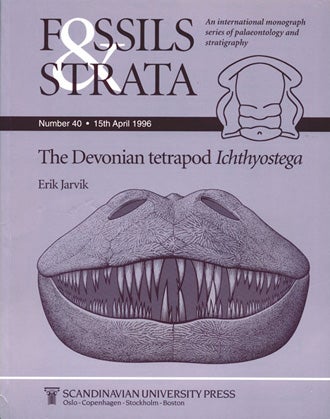
Jarvik is best known for his (now mostly superseded) work on Ichthyostega. Credit: Andrew Isles Natural History Books
This concept was (and is) generally known as the ‘diphyletic hypothesis’. Convention has it that it was only ever advocated and promoted by the several workers of the so-called Stockholm School, a group of researchers at the Swedish Museum of Natural History, specifically Nils Holmgren, Gunnar Säve-Söderbergh and Erik Jarvik. Such views were actually quite widespread, however: Trueb & Cloutier (1991) noted that “the majority of authors [of the first half of the 20th entury seem] to have proposed a diphyletic origin of the Amphibia, but as a point of clarity it should be noted that most did not consider caecilians in their studies” (p. 177). They listed papers by numerous additional authors who also supported or favoured a diphyletic origin for modern amphibians. It has to be remembered that workers at this time didn’t know of as many temnospondyl and other non-amniote tetrapod taxa as we do today: a single potential group of animals that might have given rise to the living group was not recognised nor – as a consequence – was there a clear model of lissamphibian origins.
Whatever, Jarvik and colleagues were certainly the most influential of those arguing for diphyly. In a series of papers published from the 1930s onwards, Jarvik argued that the ethmoid region (located in the middle of the skull, between the snout and braincase) of salamanders allied them with porolepiforms and not with osteolepiforms, the group otherwise thought to include the ancestry of all tetrapods (e.g., Jarvik 1942, 1972, 1980). He called this proposed porolepiform + salamander group Urodelomorpha and was still pushing this idea as recently as 1986 (Jarvik 1986). This meant that reviews published late that decade and even in the following one were still spending time refuting it (Panchen & Smithson 1987, Schultze 1991).
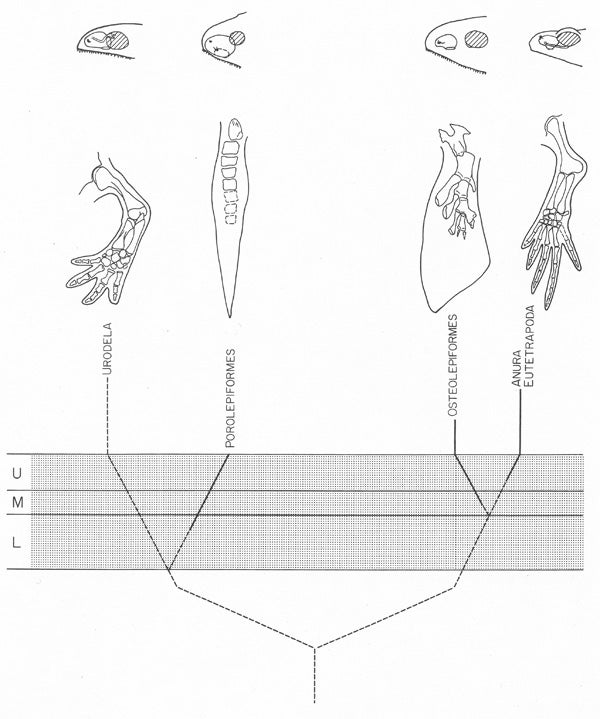
Jarvik's hypothesis of tetrapod diphyly, as depicted by Schultze (1991). The diagrams show how Jarvik pointed to supposed similarities between the nasal capsule and nasolacrimal duct of salamanders with that of porolepiforms, there also being the implication that the salamander forelimb looks more likely to have been derived from that of porolepiforms than osteolepiforms. Credit: Schultze 1991
Skip back to the 1930s and 40s, and Holmgren and Säve-Söderbergh argued how salamander limbs linked them to lungfishes, and not to true tetrapods or their immediate ancestors (Holmgren 1933, 1939, 1949a, b).
Just think about these ideas for a moment. When you look at a salamander – so Jarvik and colleagues proposed – you are seeing a terrestrialised mimic of tetrapods that has evolved from lungfishes or lungfish relatives. This concept is not impossible, for sure, but... wow, how radical.
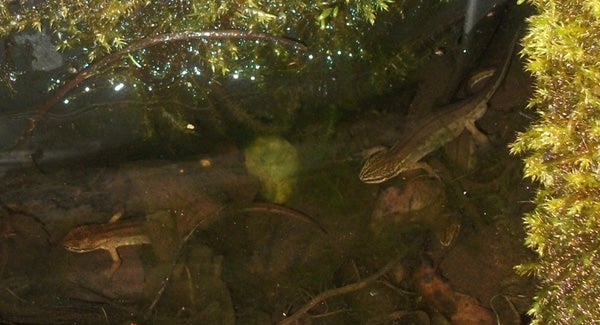
These look like tetrapods to me. But under the diphyletic hypothesis, they would be tetrapod-mimicking members of the lungfish lineage. These are actually Palmate newts Lissotriton helveticus (there are three animals in the photo; can you spot them all?). Credit: Darren Naish
By the late 1950s it would appear that other workers were not much swayed by these proposals. Eaton (1959), in a review of modern amphibian origins, wrote that “this work is most detailed and laborious, and has produced a great quantity of data useful to morphologists, but … is not widely adopted” (p. 161). Schoch & Milner (2004) noted that Jarvik “was the principal advocate of this view, which had few other supporters, and since his death, no other worker has continued to promote it” (p. 346). The claims about the ethmoid region were soon argued in convincing detail to be due to mistaken interpretations and were in any case outweighed by the much larger number of anatomical characters linking salamanders with other tetrapods.
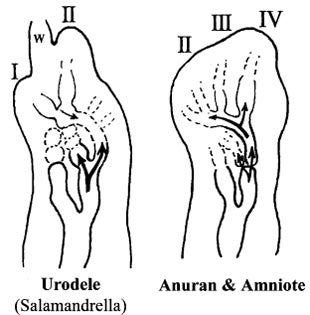
Salamander limb development is weird, and this weirdness was interpreted as lungfish-like by authors like Holmgren. Credit: Hinchliffe 2002
As for those ideas about salamander limbs being somehow lungfish-like: well, they were all based on perceived patterns of cartilage condensation patterns in embryos. Today we appreciate that salamander limb development is indeed odd compared to that of other tetrapods (for one thing, the digits on the preaxial side develop first; postaxial digits develop first in other tetrapods): the pattern seen in developing salamander limbs does indeed create a pattern that looks superficially lungfish-like. Rather than being evidence of lungfish (or porolepiform) ancestry, it now seems that the weirdness of this pattern is due to complexity in the pattern of digit development that was unappreciated prior to recent decades (Franssen et al. 2001, Hinchliffe 2002).
More ‘non-standard hypotheses’ relevant to amphibians very soon! Support me at patreon and you get to see this stuff as it comes together.
For previous Tet Zoo articles on ‘non-standard hypotheses’, see...
Refs - -
Eaton, T. H. 1959. The ancestry of modern Amphibia: a review of the evidence. University of Kansas Publications, Museum of Natural History 12, 155-180.
Franssen, R. A., Marks, S., Wake, D. & Shubin, N. 2001. Limb chondrogenesis of the Seepage salamander, Desmognathus aeneus (Amphibia: Plethodontidae). Journal of Morphology 265, 87-101.
Holmgren, N. 1933. On the origin of the tetrapod limb. Acta Zoologica 14, 185-295.
Holmgren, N. 1939. Contributions to the question of the origin of the tetrapod limb. Acta Zoologica 30, 459-484.
Holmgren, N. 1949a. Contributions to the question of the origin of tetrapods. Acta Zoologica 30, 459-484.
Holmgren, N. 1949b. On the tetrapod limb problem again. Acta Zoologica 30, 485-508.
Jarvik, E. 1942. On the structure of the snout of crossopterygians and lower gnathostomes in general. Zoologiska Bidrag Fran Uppsala 21, 235-675.
Jarvik, E. 1972. Middle and Upper Devonian Porolepiformes from East Greenland with special reference to Glyptolepis groelandica n. sp. and a discussion on the structure of the head in the Porolepiformes. Meddelelser om Grønland 187, 1-307.
Jarvik, E. 1980. Basic Structure and Evolution of Vertebrates. Academic Press, London.
Panchen, A. L. & Smithson, T. R. 1987. Character diagnosis, fossils and the origin of tetrapods. Biological Reviews 62, 341-438.
Schoch, R. R., Milner, A. R. 2004. Structure and implication of theories on the origin of lissamphibians. In Arratia, G., Wilson, M. V. H. & Cloutier, R. (eds) Recent Advances in the Origin and Early Radiation of Vertebrates. Verlag Dr. Friedrich Pfeil (München), pp. 345-377.
Schultze, H.-P. 1991. A comparison of controversial hypotheses on the origin of tetrapods. In Schultze, H.-P. & Trube, L. (eds) Origins of the Higher Groups of Tetrapods, Controversy and Consensus. Comstock/Cornell University Press (Ithaca and London), pp. 29-67.
Trueb, L. & Cloutier, R. 1991. Toward an understanding of the amphibians: two centuries of systematic history. In Schultze, H.-P. & Trueb, L. (eds) Origins of the Higher Groups of Tetrapods, Controversy and Consensus. Comstock/Cornell University Press (Ithaca and London), pp. 175-193.